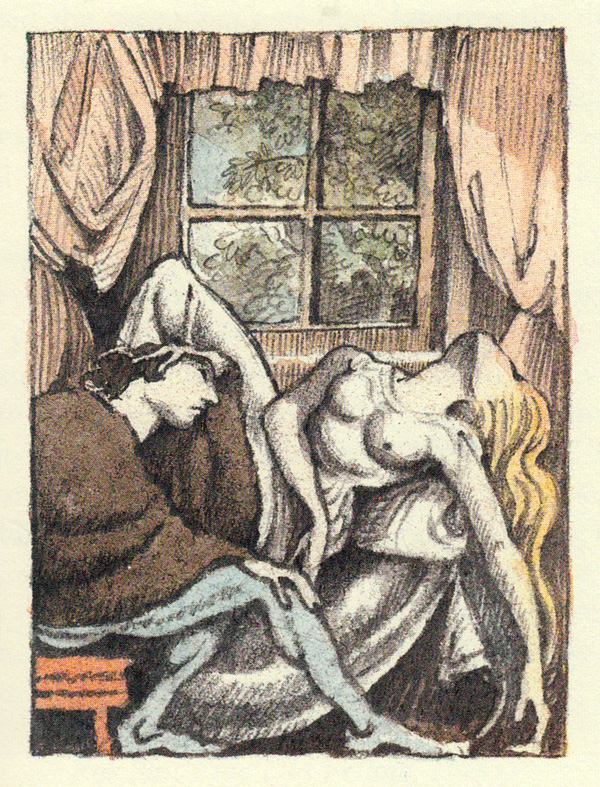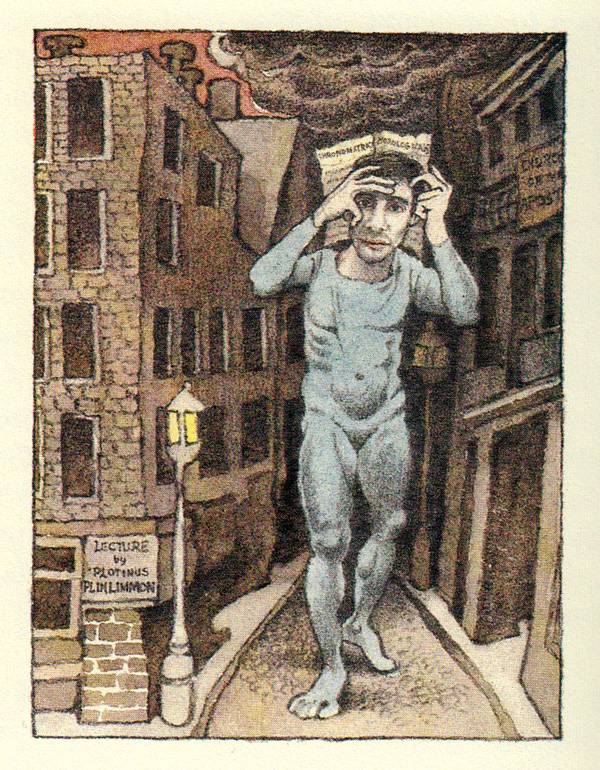I suppose Alice in Wonderland and Through the Looking-glass are right on the margins, and it is debatable whether they were truly written for adults or children. Nonetheless, when I think of books that are basically inseparable from their illustrations, this is the one example that always springs to mind. John Tenniel's sketches are so incredible that one really ought not to try to redo them, though some illustrators have tried.
I generally find Ralph Steadman's illustrations for Alice a bit too crude, with most of the soldiers looking like they strolled in from the set of Kubrick's A Clockwork Orange, but I did think this one with Alice growing too large for the house was effective.
Perhaps it should be no surprise that Salvador Dali illustrated Alice in Wonderland, though with only one image per chapter, so many interesting events were left out. Here is Alice caught in the pool of tears.
That does seem to be the trade-off, that major 20th Century artists like Dali or Picasso or Chagall will illustrate a book, but with only a relatively small number of plates.
Another extremely prominent illustrator was Gustave Doré, who illustrated the Bible, Dante's Divine Comedy and Cervante's Don Quixote with over 100 plates for each, in other words almost all key episodes are captured with a full-page plate. There are a bunch of resources out there on these illustrations, as they are out of copyright. I recently picked up a pretty nice copy of Dante's The Divine Comedy with Doré's illustrations, though the translation is by Longfellow, so somewhat out of date and certainly a different style than we are used to now.
I actually have two relatively modern translations of Don Quixote, neither of which have the Doré plates, so in this case, I might pick up a publication by Dover that only contains the Quixote plates. For his illustrations from the Bible, I'll just get them from Project Gutenberg.
 |
| Inferno, Canto 7 |
 |
| Paradiso, Canto 31 |
 |
| Don Quixote |
 |
| Dali's Don Quixote |
 |
| Picasso's Don Quixote |
It isn't that much of a surprise that Marc Chagall illustrated the Bible, but he also tackled books that had some dreamlike aspect to them, so he illustrated La Fontaine's Fables (again arguable whether this is primarily aimed at children) and Tales from the Arabian Nights. Below I have included his illustrations for The Ox and the Frog and what is probably the tale of Abdullah the Fisherman from the Arabian Nights.
I'm really not sure how many books Picasso did illustrate, but one of his more interesting efforts was a set of 30 etchings for Ovid's Metamorphoses, 15 of which are full-page illustrations. I'll have to see if I have all or most of these already. Even doing a bit of background research to fill in this post has led me to want to buy a few more art books. I'll have to try to be strong.
One of the more surprising entries into this category of illustrated books is Dos Passos and his U.S.A Trilogy.
While the most commonly available editions of the Trilogy (the Modern Library and Library of America one volume editions) do not have these illustrations by the artist Reginald Marsh, several editions with the books bound separately do have them. There are quite a number of these line-drawings, but only in the main sections, i.e. Marsh doesn't provide illustrations for the thumbnail sketches or The Camera Eye or the Newsreel sections. I've only seen the ones from 1919, but I liked them quite a bit (even if he has a few too many ships and not enough café scenes), and after a bit of hesitation (due to not planning on rereading the trilogy), I ordered a copy that is supposed to have these illustrations.
That finally brings me around to another special edition -- the "Kraken" edition of Melville's Pierre illustrated by Maurice Sendak, which I discussed here. I found out about this in a really roundabout way. The Art Spiegelman exhibit had some panels where he (Spiegelman) was illustrating a talk he had had with Sendak where the Pierre project came up. So I did a bit of on-line sleuthing and found out about this project. This edition is OOP, but there are still some floating around. I won a copy off eBay and one of these days hope to check it out in person. I'll close this post with just a couple more of these fascinating images.













No comments:
Post a Comment